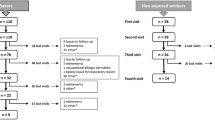Abstract
We have compared the bronchial responsiveness (BR) of 12 aluminum potroom workers (index group) who were relocated due to work-related asthmatic symptoms (WASTH) and 26 subjects (reference group) with WASTH who continued to work in pot-rooms. The subjects were examined at regular intervals during a 2-year follow-up period. BR was expressed as the log-transformed dose-response slope [Ln (DRS + 0.5)]. The monthly change in BR (ΔBR) in the index group was −4.87 × 10−2 compared with −1.58 × 10−2 in the reference group. After adjustment for potential confounders, the difference between the index group and the reference group was −2.39 × 10−2 (95% CI: −4.07 × 10−2 to −0.71 × 10−2), i.e. 49% of the decrease in BR in the index group could be explained by the removal from exposure. No improvement in lung function was found in the index group compared with the reference group. The results indicate that the removal of potroom workers from exposure causes a decrease in BR.
Similar content being viewed by others
References
Bakke P, Baste V, Gulsvik A (1991) Bronchial responsiveness in a Norwegian community. Am Rev Respir Dis 143:317–322
Cockcroft DW, Killian DN, Mellon JJA, Hargeave FE (1977) Bronchial reactivity to inhaled histamine: a method and a clinical survey. Clin Allergy 7:235–243
Davis CE (1976) The effect of regression to the mean in epidemiologic and clinical studies. Am J Epidemiol 104:493–498
Diem JE, Liukkonen JR (1988) A comparative study of three methods for analysing longitudinal pulmonary function data. Stat Med 7:19–28
Enarson DA, Vedal S, Shulzer M, Dybuncio A, Chan-Yeung M (1987) Asthma, asthmalike symptoms, chronic bronchitis, and the degree of bronchial hyperresponsiveness in epidemiologic surveys. Am Rev Respir Dis 136:613–617
Fabbri LM, Boschetto P, Zocca E, Milani G, Pivivrotto F, Plebani M, Burlina A, Licata B, Mapp CE (1987) Bronchoalveolar neutrophilia during late asthmatic reactions induced by toluene diisocyanate. Am Rev Respir Dis 136:36–42
Gulsvik A (1979) Obstructive lung disease in an urban population (dissertation). Rikshospitalet, University Hospital, Oslo
Holgate ST, Roche W, Djukanovic R, Wilson J, Britten K, Howarth P (1991) The need for a pathological classification of asthma. Eur Respir J 4 (Suppl 13):113–122
James KE (1973) Regression toward the mean in uncontrolled clinical studies. Biometrics 29:121–130
Kelly C, Ward C, Stenton CS, Bird G, Hendrick DJ, Walters EH (1988) Number and activity of inflammatory cells in bronchoalveolar lavage fluid in asthma and their relation to airway responsiveness. Thorax 43:684–692
Kongerud J, Aalen OO, Vale JR (1989) Questionnaire reliability and validity for aluminum potroom workers. Scand J Work Environ Health 15:364–370
Kongerud J, Soyseth V (1991) Methacholine responsiveness, respiratory symptoms and pulmonary function in aluminum potroom workers. Eur Respir J 4:159–166
Miller MR, Pincock AP (1988) Predicted values: how should we use them? (editorial). Thorax 43:265–267
O'Connor G, Sparrow D, Taylor D, Segal M, Weiss S (1987) Analysis of dose-response curves to methacholine. Am Rev Respir Dis 136:1412–1417
O'Donnel TV, Welford B, Coleman ED (1989) Potroom asthma: New Zealand experience and follow-up. Am J Ind Med 15:43–49
Ohashi Y, Motojima S, Fukuda T, Makino S (1992) Airway hyperresponsiveness, increased intracellular spaces of bronchial epithelium, and increased infiltration of eosinophils and lymphocytes in bronchial mucosa in asthma. Am Rev Respir Dis 145:1469–1476
Saric M, Marelja J (1991) Bronchial hyperreactivity in potroom workers and prognosis after stopping exposure. Br J Ind Med 48:653–655
Senn SJ, Brown RA (1985) Estimating treatment effects in clinical trials subject to regression to the mean. Biometrics 41:555–560
Søyseth V, Kongerud J, Boe J, Fonneland T (1992) Bronchial responsiveness and work-related asthma in aluminum potroom workers. Eur Respir J 5:829–833
Søyseth V, Kongerud J, Kjuus H, Boe J (1994) Bronchial responsiveness and decline in FEV1 in aluminum potroom workers. Eur Respir J 7:888–894
Wilkinson L (1990) SYSTAT: The system for statistics. SYSTAT, Inc., Evanston, Ill.
Author information
Authors and Affiliations
Rights and permissions
About this article
Cite this article
Søyseth, V., Kongerud, J., Aalen, O.O. et al. Bronchial responsiveness decreases in relocated aluminum potroom workers compared with workers who continue their potroom exposure. Int. Arch Occup Environ Heath 67, 53–57 (1995). https://doi.org/10.1007/BF00383133
Received:
Accepted:
Issue Date:
DOI: https://doi.org/10.1007/BF00383133




